Deep proteomic profiling of vasopressin-sensitive collecting duct cells. II. Bioinformatic analysis of vasopressin signaling
- PMID: 26310817
- PMCID: PMC4683213
- DOI: 10.1152/ajpcell.00214.2015
Deep proteomic profiling of vasopressin-sensitive collecting duct cells. II. Bioinformatic analysis of vasopressin signaling
Abstract
Vasopressin controls osmotic water transport in the renal collecting duct through regulation of aquaporin-2 (AQP2). We carried out bioinformatic analysis of quantitative proteomic data from the accompanying article to investigate the mechanisms involved. The experiments used stable isotope labeling by amino acids in cell culture in cultured mpkCCD cells to quantify each protein species in each of five differential-centrifugation (DC) fractions with or without the vasopressin analog 1-desamino-8-d-arginine-vasopressin (dDAVP). The mass spectrometry data and parallel Western blot experiments confirmed that dDAVP addition is associated with an increase in AQP2 abundance in the 17,000-g pellet and a corresponding decrease in the 200,000-g pellet. Remarkably, all subunits of the cytoplasmic ribosome also increased in the 17,000-g pellet in response to dDAVP (P < 10(-34)), with a concomitant decrease in the 200,000-g pellet. Eukaryotic translation initiation complex 3 (eIF3) subunits underwent parallel changes (P < 10(-6)). These findings are consistent with translocation of assembled ribosomes and eIF3 complexes into the rough endoplasmic reticulum in response to dDAVP. Conversely, there was a systematic decrease in small GTPase abundances in the 17,000-g fraction. In contrast, most proteins, including protein kinases, showed no systematic redistribution among DC fractions. Of the 521 protein kinases coded by the mouse genome, 246 were identified, but many fewer were found to colocalize with AQP2 among DC fractions. Bayes' rule was used to integrate the new colocalization data with prior data to identify protein kinases most likely to phosphorylate aquaporin-2 at Ser(256) (Camk2b > Camk2d > Prkaca) and Ser(261) (Mapk1 = Mapk3 > Mapk14).
Keywords: aquaporin-2; mass spectrometry; phosphorylation; protein kinase; ribosome; small GTPase; translation.
Figures


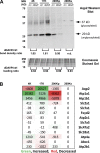

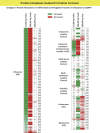

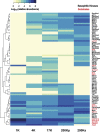

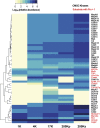

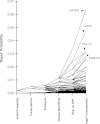

Comment in
-
Water transport running deep. Focus on "Deep proteomic profiling of vasopressin-sensitive collecting duct cells".Am J Physiol Cell Physiol. 2015 Dec 15;309(12):C783-4. doi: 10.1152/ajpcell.00280.2015. Epub 2015 Sep 30. Am J Physiol Cell Physiol. 2015. PMID: 26423579 No abstract available.
Similar articles
-
Use of LC-MS/MS and Bayes' theorem to identify protein kinases that phosphorylate aquaporin-2 at Ser256.Am J Physiol Cell Physiol. 2014 Jul 15;307(2):C123-39. doi: 10.1152/ajpcell.00377.2012. Epub 2014 Mar 5. Am J Physiol Cell Physiol. 2014. PMID: 24598363 Free PMC article.
-
Deep proteomic profiling of vasopressin-sensitive collecting duct cells. I. Virtual Western blots and molecular weight distributions.Am J Physiol Cell Physiol. 2015 Dec 15;309(12):C785-98. doi: 10.1152/ajpcell.00213.2015. Epub 2015 Aug 26. Am J Physiol Cell Physiol. 2015. PMID: 26310816 Free PMC article.
-
Bayesian mapping of protein kinases to vasopressin-regulated phosphorylation sites in renal collecting duct.Am J Physiol Renal Physiol. 2024 Oct 1;327(4):F591-F598. doi: 10.1152/ajprenal.00142.2024. Epub 2024 Jul 18. Am J Physiol Renal Physiol. 2024. PMID: 39024358
-
Molecular mechanisms regulating aquaporin-2 in kidney collecting duct.Am J Physiol Renal Physiol. 2016 Dec 1;311(6):F1318-F1328. doi: 10.1152/ajprenal.00485.2016. Epub 2016 Oct 19. Am J Physiol Renal Physiol. 2016. PMID: 27760771 Free PMC article. Review.
-
Aquaporin-2 abundance in the renal collecting duct: new insights from cultured cell models.Am J Physiol Renal Physiol. 2009 Jul;297(1):F10-8. doi: 10.1152/ajprenal.00053.2009. Epub 2009 Feb 25. Am J Physiol Renal Physiol. 2009. PMID: 19244407 Review.
Cited by
-
A resource database for protein kinase substrate sequence-preference motifs based on large-scale mass spectrometry data.Cell Commun Signal. 2024 Feb 19;22(1):137. doi: 10.1186/s12964-023-01436-2. Cell Commun Signal. 2024. PMID: 38374071 Free PMC article.
-
T cell microvilli constitute immunological synaptosomes that carry messages to antigen-presenting cells.Nat Commun. 2018 Sep 7;9(1):3630. doi: 10.1038/s41467-018-06090-8. Nat Commun. 2018. PMID: 30194420 Free PMC article.
-
Protein phosphatase 2C is responsible for VP-induced dephosphorylation of AQP2 serine 261.Am J Physiol Renal Physiol. 2017 Aug 1;313(2):F404-F413. doi: 10.1152/ajprenal.00004.2017. Epub 2017 Apr 5. Am J Physiol Renal Physiol. 2017. PMID: 28381458 Free PMC article.
-
Phosphoproteomic identification of vasopressin V2 receptor-dependent signaling in the renal collecting duct.Am J Physiol Renal Physiol. 2019 Oct 1;317(4):F789-F804. doi: 10.1152/ajprenal.00281.2019. Epub 2019 Jul 17. Am J Physiol Renal Physiol. 2019. PMID: 31313956 Free PMC article.
-
Recommendations for Development and Validation of a Fit-For-Purpose Biomarker Assays Using Western Blotting; An-AAPS Sponsored Initiative to Harmonize Industry Practices.AAPS J. 2024 Jul 25;26(5):87. doi: 10.1208/s12248-024-00946-2. AAPS J. 2024. PMID: 39060472
References
-
- Alberts B, Johnson A, Lewis J, Raff M, Roberts K, Walter P. Molecular Biology of the Cell. New York: Garland Science, 2002.
Publication types
MeSH terms
Substances
Grants and funding
LinkOut - more resources
Full Text Sources
Other Literature Sources
Molecular Biology Databases
Miscellaneous

